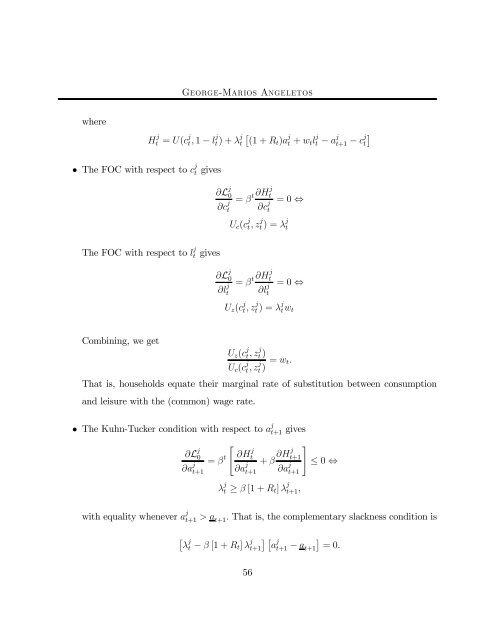14.451 Lecture Notes Economic Growth
14.451 Lecture Notes Economic Growth
14.451 Lecture Notes Economic Growth
You also want an ePaper? Increase the reach of your titles
YUMPU automatically turns print PDFs into web optimized ePapers that Google loves.
where<br />
• The FOC with respect to c j<br />
t gives<br />
George-Marios Angeletos<br />
H j<br />
t = U(c j<br />
t, 1 − l j<br />
t )+λ j £<br />
t (1 + Rt)a j<br />
t + wtl j<br />
t − a j<br />
t+1 − c j¤<br />
t<br />
The FOC with respect to l j<br />
t gives<br />
∂L j<br />
0<br />
∂c j<br />
t<br />
∂L j<br />
0<br />
∂l j<br />
t<br />
t ∂Hj t<br />
= β<br />
∂c j<br />
t<br />
Uc(c j<br />
t,z j<br />
t )=λ j<br />
t<br />
t ∂Hj t<br />
= β<br />
∂l j<br />
t<br />
=0⇔<br />
=0⇔<br />
Uz(c j<br />
t,z j<br />
t )=λ j<br />
twt<br />
Combining, we get<br />
Uz(c j<br />
t,z j<br />
t )<br />
Uc(c j<br />
t,z j = wt.<br />
t )<br />
That is, households equate their marginal rate of substitution between consumption<br />
and leisure with the (common) wage rate.<br />
• The Kuhn-Tucker condition with respect to a j<br />
t+1 gives<br />
∂L j<br />
0<br />
∂a j<br />
t+1<br />
= β t<br />
"<br />
∂H j<br />
t<br />
∂a j<br />
t+1<br />
+ β ∂Hj<br />
t+1<br />
∂a j<br />
t+1<br />
λ j<br />
t ≥ β [1 + Rt] λ j<br />
t+1,<br />
#<br />
≤ 0 ⇔<br />
with equality whenever a j<br />
t+1 >a t+1. That is, the complementary slackness condition is<br />
£ j<br />
λt − β [1 + Rt] λ j ¤£ j ¤<br />
t+1 at+1 − at+1 =0.<br />
56

















